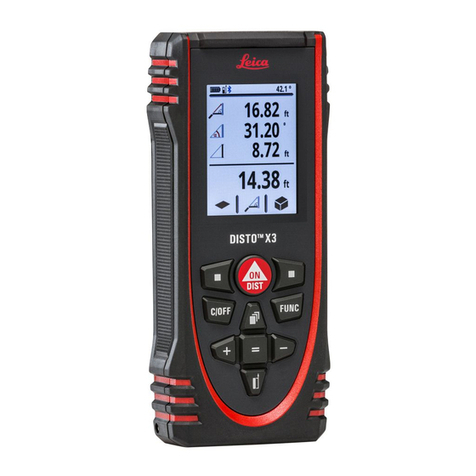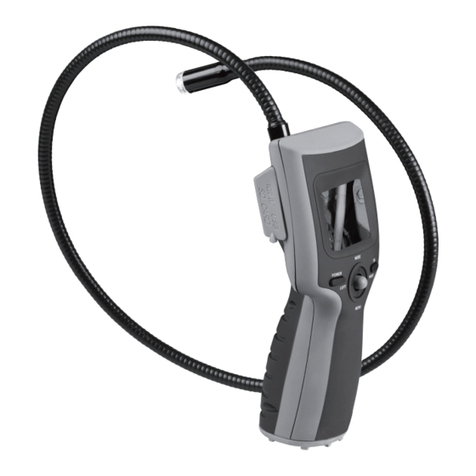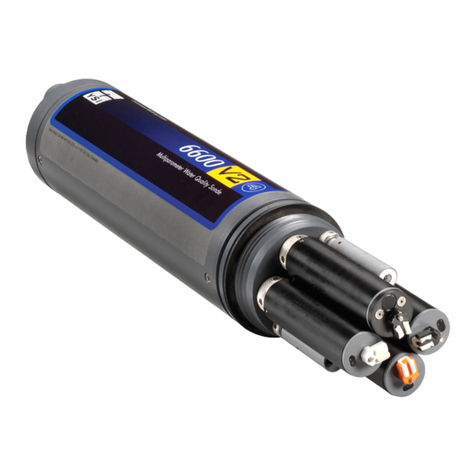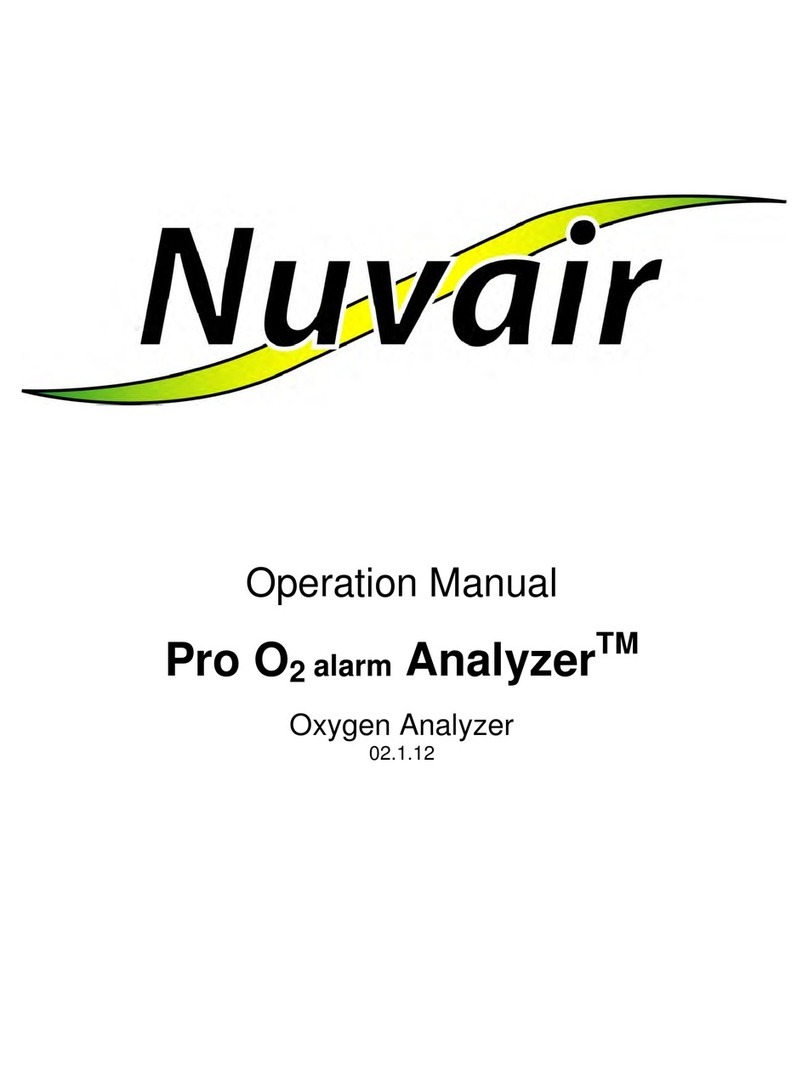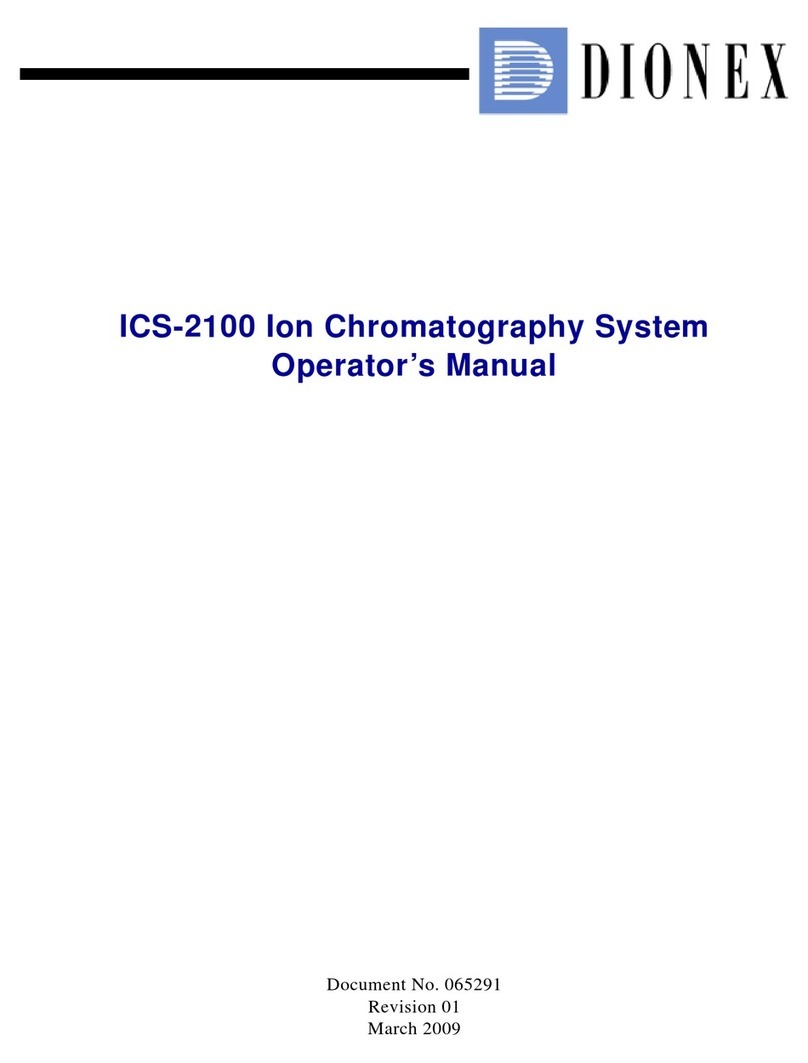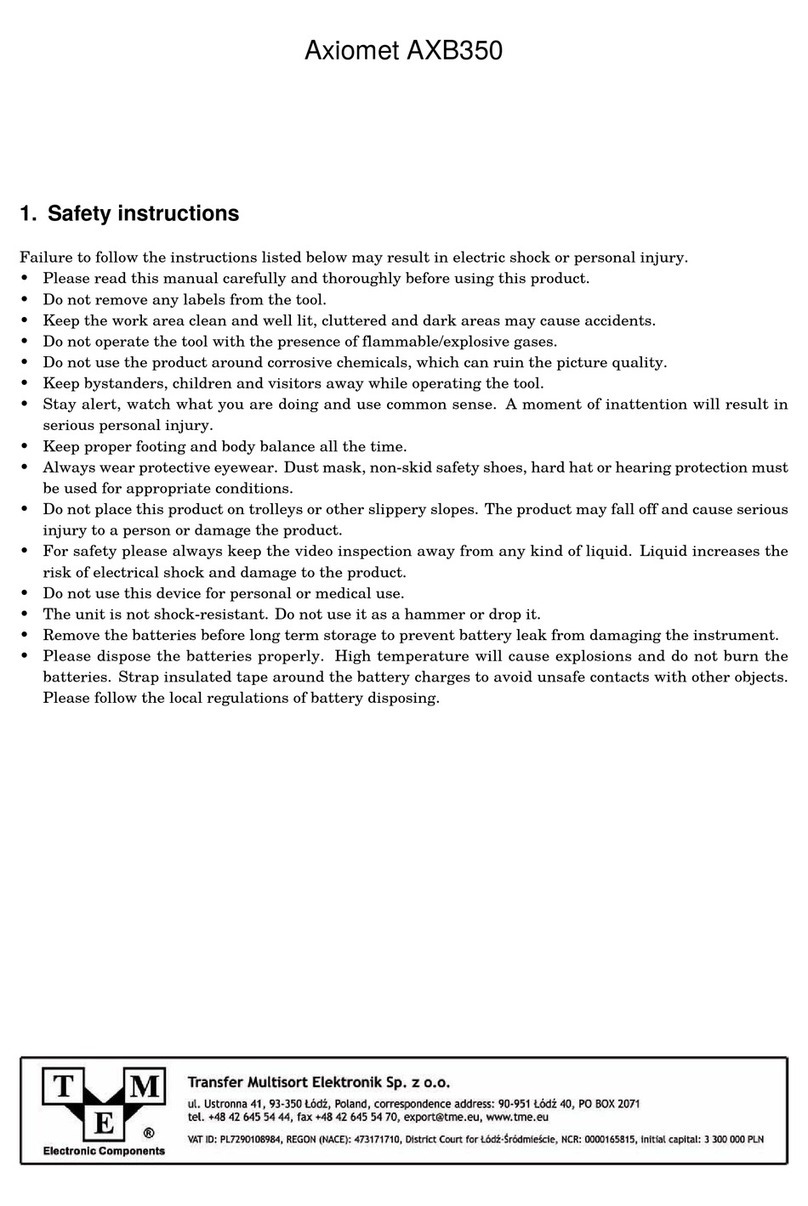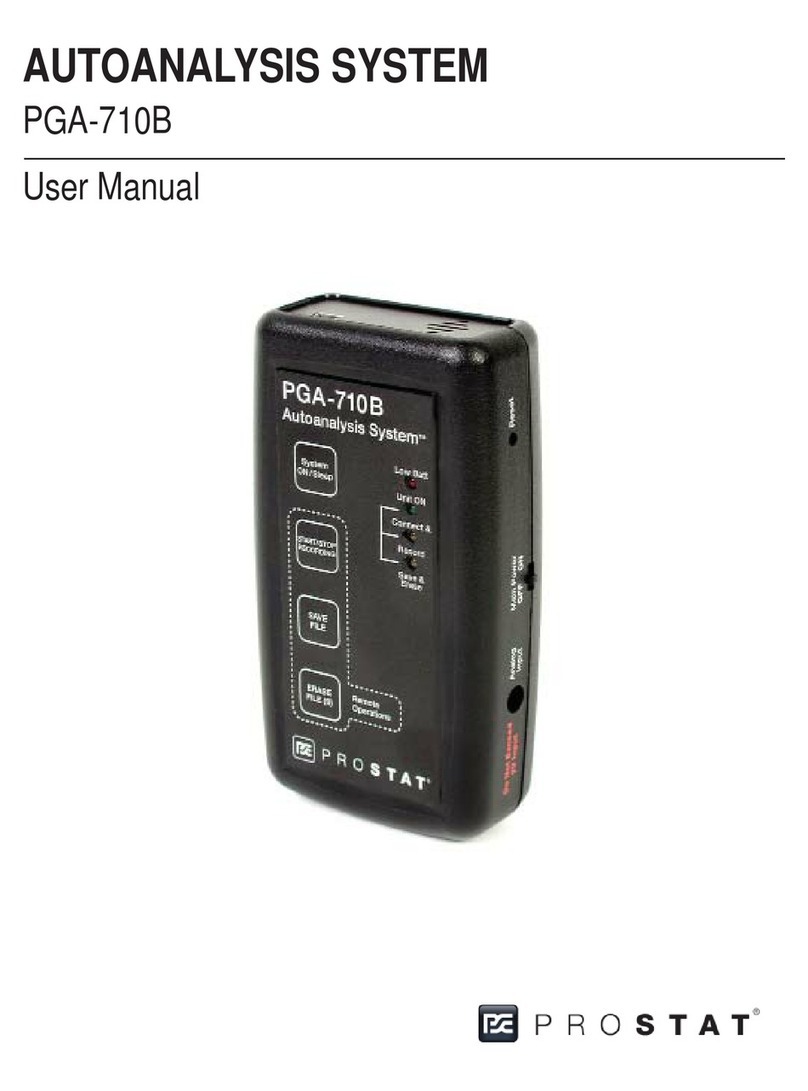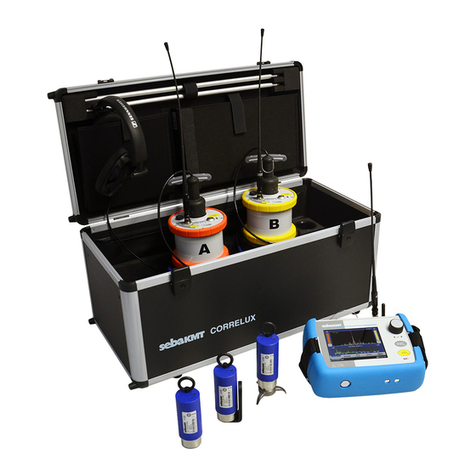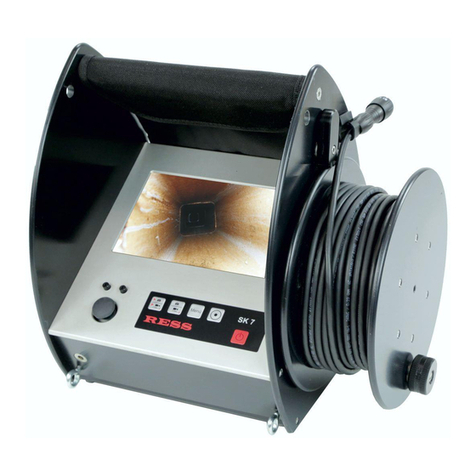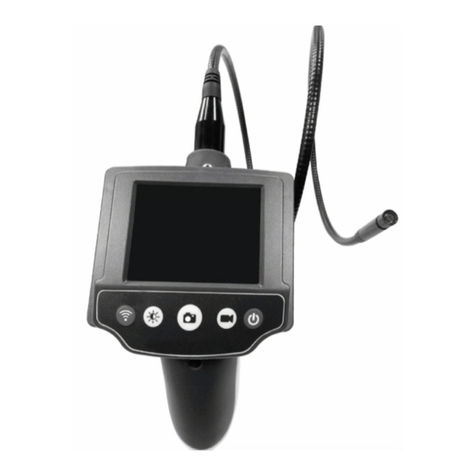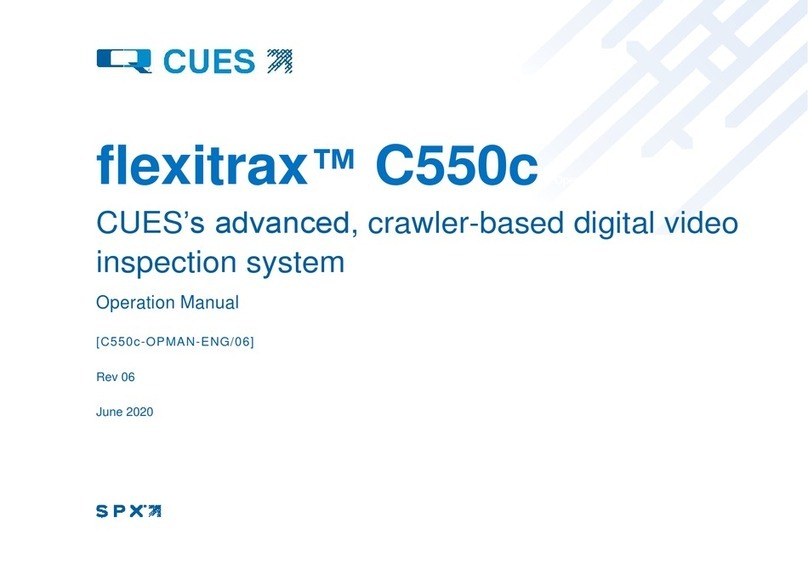TOAD OBM-162A User manual

Please keep this instruction manual close at hand of the persons who are in charge of
the operation of this product.
Before operating this product, please read this instruction manual carefully for its
correct handling.
DISSOLVED OXYGEN
ANALYZER
MODEL OBM-162A
No. OBM-IB54802E

Model: OBM-162A Introduction
-
1
-
Introduction
(a)Thank you for your purchase of our product. The Model OBM-162A Dissolved Oxygen Analyzer
(hereafter called the analyzer or the product) is an indicating analyzer in a measurement system to
measure the dissolved oxygen (DO) in various solutions.
When extension cable is used
Extension cable
Connector box
Electrode holder
Electrode
Sensor
(electrode + electrode holder)
Analyzer
Model OBM-162A
Recorder, etc.
Example of Measurement System
(b)The full DO measuring range is 0.00 to 50.00mg/L. Though the measuring range can be arbitrarily
selected within this range, the range is normally set according to the ordered specification. The
power supply voltage is 100 to 240VAC±10%. For other specifications, refer to 6.1
“Specifications”.
(c)The following screens are provided. Among them, DO measured value and temperature measured
value are sent out as transmission output.
DO Measured Value Screen (unit: mg/L) ···· Dissolved oxygen concentration in water
O2Measured Value Screen (unit: %) ········· Oxygen (O2) concentration in the air
SAT Measured Value Screen (unit: %) ······· Saturation ratio of dissolved oxygen in water
(hereafter called SAT)
Temperature Display Screen (°C) ············ Temperature in water
(d)This analyzer is adjusted to conform to electrodes with the following temperature element.
•Temperature element of 10kΩ/25°C (thermistor) ······ Models 7533L, 7536L, 7540L, etc.
(e)To detect breaking of the diaphragm, the analyzer must be combined with a Model 7540L electrode
and Model ELW-067 connection lead wire (options).
(f) Since this manual mainly explain about the analyzer, refer to the instruction manual attached to the
sensor for the sensor combined with the analyzer.
(g)The product may indicate or output an incorrect measured value due to the following reasons. We
recommend preparing a system such that the related facilities will not be damaged even in cases
like these.
•Any problem of the product such as deterioration or damage of the detecting section or
inappropriate insulation of cables.
•Improper setting of operating conditions or calibration operation.
•Electrical interference such as noise in the vicinity or improper grounding.

Model: OBM-162A Introduction
-
2
-
•Other unpredictable phenomena
(h)Since important items are described in “Safety Information,” read the contents carefully.
(i) The product should be handled by persons who have received proper training. In addition, for
technical services such as repairs, ask a specialist to do who is qualified for the technical
certification system in our company or a person who has technical skills equivalent to that
certification system.

Model: OBM-162A Safety Information
-
3
-
Safety Information
(1) Meaning of markings
The signal terminology and symbols related to warnings in the instruction manual are defined below.
The alert symbol mark ( : General caution mark) indicates the possibility of hazard or damage and
also means “Refer to the instruction manual.”
:
Indicates the degree of hazard which can lead to death or serious injury if you fail to operate the
product properly.
Serious injury means an injury such as loss of sight, burns (high temperature or low temperature),
electric shock, bone fracture and poisoning, and the aftereffects of the injury remains or the injury
requires hospitalization or long periods of outpatient treatment.
:
Indicates the degree of hazard/loss which can result in injury or property damage if you fail to operate
the product properly.
Injury means an injury not requiring hospitalization or long periods of outpatient treatment and refers
to burns or electric shock. Property damage refers to widespread damage to the home, household
goods and livestock, pets, equipment, materials, etc. (damage to other than the product itself).
【IMPORTANT】: Indicates important matters other than and . They are the
matters such as preventing damage to the product main body, preventing data
destruction, preventing wasting time, maintaining performance, and observing
regulations.
〔NOTE〕 : Indicates comments, reasons, background information, a case example and other
items to help the reader understand the meaning.
>>: Indicates reference items.
①, ②, ③: Indicates item numbers such as the ones used in operations.
(2) Safety compliance items
Hazardous Gasses
Do not use the product in an area where explosive gas or flammable gas exists.
Using the product in any of these areas can cause explosion or fire.
Electric Shock
Do not touch the terminals inside the product while power is applied. Touching the
terminals can cause electric shock.
The ground terminal must be grounded. If the ground terminal is not grounded,
electric shock can result if a problem occurs in the power system.

Model: OBM-162A Safety Information
-
4
-
Disassembly and Modification
Do not disassemble or modify the sections of the product that are not described in
the instruction manual. The product can be damaged.
Warning Label Lost
If any warning label affixed to this product becomes too difficult to read or lost,
please order a new one through your local sales agent or our sales office and affix it
to its original position.
(3) Notes on use of the instruction manual
Important items such as “Safety compliance items” are described in this manual. Handle the manual
as follows:
(a)The instruction manual is required not only at the start of operation but also required when
maintenance is performed or in case a failure occurs. Please keep the manual at hand all the time so
that the operator who actually operates the product can read the manual at any time.
(b)If the manual is lost or too smeared to read, please order a new copy through your local sales agent
or directly from our sales office.
(c)For easier comprehension, some of the diagrams used in the manual or on product labels may be
modified with part of their shapes or displays omitted or they may be described in abstract form. In
addition, numbers etc. shown on the screen example are just examples for such cases.
(d)The contents of the manual may be changed without prior notice for reasons such as to improve
performance.
(e)Intellectual property right of the manual belongs to DKK-TOA. All or part of the manual must not
be reproduced without permission.

Model: OBM-162A Warranty
-
5
-
Warranty
(1) Warranty Coverage
DKK-TOA Corporation (DKK-TOA) warrants its products against defective material or workmanship for the warranty
period.
(a) The warranty period is one year from the date of delivery to the original user. If the date of delivery cannot be
specified, the warranty period is 24 months from the month following the date of manufacture shown on the
product nameplate.
(b) Specific written agreements with DKK-TOA, if any, shall take precedence over this warranty.
(c) The limitation of warranty described herein may not apply where applicable laws do not allow such limitation.
(2) Limited Warranty
This warranty does not cover the cases listed below.
(a) Direct or indirect failure or damage caused by the use of the product for a purpose or in a manner not prescribed by
the specifications or the instruction manual for the product.
(b) Direct or indirect failure or damage caused by force majeure, including but not limited to an act of God, natural
disaster such as earthquake, storm and flood damage, and lightning, fire, accident, abnormal voltage, salt damage,
gas damage, labor unrest, acts of war (declared or undeclared), terrorism, .civil strife, or acts of any governmental
jurisdiction.
(c) Failure or damage caused by any repair or modification not authorized by DKK-TOA.
(d) Failure or damage caused by the transport, moving, or dropping of the product after the purchase that is not
attributable to DKK-TOA.
(e) Electrodes and consumables (The warranty period for each part has priority when the period is shorter than that for
the main unit of the product. If the customer requires any part after more than six months from the date of
manufacture, consult DKK-TOA or its distributor.)
( f ) Failure or damage caused by the use of consumables, parts, or software not supplied by DKK-TOA.
(g) Malfunctions or damage caused by the use of connecting equipment not supplied by DKK-TOA.
(h) Loss of data, settings, programs, or software stored on the product not attributable to DKK-TOA.
( i ) Any product other than DKK-TOA’s, if specified by the purchaser or user, that incorporates, or is incorporated into
or combined with DKK-TOA’s products (*1). In such cases, this warranty covers DKK-TOA’s products only.
( j ) Any product not under proper maintenance in accordance with the instruction manual furnished by DKK-TOA.
(k) Products without a nameplate (excluding products proved to have been delivered by DKK-TOA).
EXCEPT AS EXPRESSLY SET FORTH IN THE PRECEDING SENTENCES, DKK-TOA MAKES NO
WARRANTY OF ANY KIND WHATSOEVER WITH RESPECT TO ANY PRODUCT. DKK-TOA EXPRESSLY
DISCLAIMS ANY WARANTY IMPLIED BY LAW, INCLUDING BUT NOT LIMITED TO ANY WARRANTY OF
MERCHANTABILITY OR FITNESS FOR A PARTICULAR PURPOSE.
LIMITATION OF REMEDIES: In the event that a defect is discovered within the warranty period, DKK-TOA or its
authorized distributor will, at its option, repair or replace the defective product or its part, or will refund the purchase
price of the product. THIS IS THE EXCLUSIVE REMEDY FOR ANY BREACH OF WARRANTY.
LIMITATION OF DAMAGES: IN NO EVENT SHALL DKK-TOA BE LIABLE FOR ANY INCIDENTAL OR
CONSEQUENTIAL DAMAGES OF ANY KIND FOR BREACH OF ANY WARRANTY, NEGLIGENCE, ON THE
BASIS OF STRICT LIABILITY, OR OTHERWISE.
(3) Others
(a) Product parts for maintenance (*2) will normally be supplied for five years (*3) from the date manufacturing and
sales are discontinued.
(b) The cause of any malfunction or damage shall be determined by a DKK-TOA technician.
(c) For repairs, contact a local distributor in your country or state.
*1: Warranties for products from other companies must be maintained by the user.
*2: Maintenance parts refers to parts that are required to maintain operation of the product.
*3: This five-year period is subject to availability of parts or their replacement.

Model: OBM-162A Reading Guide
-
6
-
Reading Guide
Refer to the necessary sections of this instruction manual depending on your purposes such as
understanding the outline of this product or starting the product as shown below. The numbers in
circles indicate sections to be referred to in sequential order.
Start
(start-up)
Understand
the outline of
this product
Check
installation,
piping and
wiring
Purpose
Section
Perform
respective
operations
Maintenance
and inspection,
and
troubleshooting
7. RS-232C Communication
Function
6. Specifications and
Description
5. Troubleshooting
4. Maintenance
3. Modes of Operations
2. Controller Operation and
Calibration
1. Control Panel Functions
●Safety Information
●Introduction
8. Installation

Model: OBM-162A Table of Contents
-
7
-
Table of Contents
●Introduction······················································································· 1
●Safety Information ········································································· 3
(1) Meaning of markings ⋅⋅⋅⋅ 3
(2) Safety compliance items ⋅⋅⋅⋅ 3
(3) Notes on use of the instruction manual ⋅⋅⋅⋅ 4
●Warranty ···························································································· 5
●Reading Guide ················································································ 6
1. Control Panel Functions ·························································10
(1) Names of main components ⋅⋅⋅⋅ 10
(2) Functions of keys and indictors ⋅⋅⋅⋅ 11
2. Operation and Calibration ······················································14
2.1 Starting the Operation········································································14
2.2 Overview of Calibration······································································17
2.3 Zero Calibration ···············································································18
(1) Zero calibration using zero solution ⋅⋅⋅⋅ 18
(2) Electrical zero calibration ⋅⋅⋅⋅ 20
2.4 Span Calibration···············································································22
(1) Span calibration using air ⋅⋅⋅⋅ 22
(2) Span calibration using air saturated water ⋅⋅⋅⋅ 23
(3) Indicated value at the time of span calibration ⋅⋅⋅⋅ 26
2.5 Stopping the Operation ······································································27
3. Modes of Operations································································28
3.1 Modes and Operation Screen Map························································28
(1) Mode Switching ⋅⋅⋅⋅ 28
(2) Operation screen map ⋅⋅⋅⋅ 29
3.2 Measurement Mode Operation·····························································32
(1) Measured value screen switching ⋅⋅⋅⋅ 32
(2) Alarm conditions ⋅⋅⋅⋅ 35
(3) DO / temperature measuring range ⋅⋅⋅⋅ 37
(4) Wash function and operational conditions (option) ⋅⋅⋅⋅ 38
(5) Other setting values ⋅⋅⋅⋅ 39
(6) Reading the calibration history data ⋅⋅⋅⋅ 41
3.3 Setting Mode Operation ·····································································44
(1) Calibration screen descriptions ⋅⋅⋅⋅ 44
(2) DO value adjust ⋅⋅⋅⋅ 47

Model: OBM-162A Table of Contents
-
8
-
(3) Temperature shift ⋅⋅⋅⋅ 48
(4) Alarm ⋅⋅⋅⋅ 49
(5) DO measuring range ⋅⋅⋅⋅ 52
(6) Temperature measuring range ⋅⋅⋅⋅ 53
(7) Wash operation (option) ⋅⋅⋅⋅ 54
(8) Manual wash (option) ⋅⋅⋅⋅ 56
(9) Zero calibration signal value and span calibration signal value ⋅⋅⋅⋅ 57
(10) 25°C saturation current value ⋅⋅⋅⋅ 58
(11) Indication item for calibration ⋅⋅⋅⋅ 59
(12) Calibration mode ⋅⋅⋅⋅ 60
(13) Hold type ⋅⋅⋅⋅ 61
(14) Response speed ⋅⋅⋅⋅ 62
(15) Stability check for calibration ⋅⋅⋅⋅ 63
(16) Impressed voltage ⋅⋅⋅⋅ 64
(17) Manual temperature compensation ⋅⋅⋅⋅ 65
(18) Date and time (clock adjustment) ⋅⋅⋅⋅ 67
(19) Measurement mode automatic return ⋅⋅⋅⋅ 68
(20) Saturated dissolved oxygen concentration ⋅⋅⋅⋅ 69
3.4 Transmission Adjustment Mode Operation··············································70
(1) DO transmission output ⋅⋅⋅⋅ 70
(2) Temperature transmission output ⋅⋅⋅⋅ 71
4. Maintenance ················································································72
4.1 Maintenance List ··············································································72
4.2 Spare Parts ·····················································································73
4.3 Operation Check Using Equivalent Input ················································73
5. Troubleshooting··········································································77
5.1 Error Message ·················································································77
(1) Error messages for calibration and necessary actions ⋅⋅⋅⋅ 77
(2) Other error messages and necessary actions ⋅⋅⋅⋅ 79
5.2 Troubleshooting Flowchart··································································81
5.3 Measures against Noise ·····································································82
6. Specifications and Description·············································83
6.1 Specifications ··················································································83
6.2 Key Points of Dissolved Oxygen Measurement········································86
(1) Factors that influence the measurement ⋅⋅⋅⋅ 86
(2) Amount of saturated dissolved oxygen in water ⋅⋅⋅⋅ 87
(3) Measurement of sample water containing salt ⋅⋅⋅⋅ 89
7. RS-232C Communication Function (Option)··················92
(1) Outline and specifications of RS-232C communication function ⋅⋅⋅⋅ 92
(2) Terminal arrangement and a dedicated communication cable ⋅⋅⋅⋅ 92

Model: OBM-162A Table of Contents
-
9
-
(3) RS-232C wiring ⋅⋅⋅⋅ 93
(4) Command format ⋅⋅⋅⋅ 93
8. Installation·····················································································95
8.1 Analyzer Mounting ············································································95
(1) Installation location ⋅⋅⋅⋅ 95
(2) Mounting example and external dimensions ⋅⋅⋅⋅ 95
8.2 Wire Connection···············································································98
(1) Wire Connection Diagram ⋅⋅⋅⋅ 98
(2) Cable ports ⋅⋅⋅⋅ 100
(3) Terminal diagram of external input/output ⋅⋅⋅⋅ 101
(4) Electrode lead wires ⋅⋅⋅⋅ 103
(5) DO transmission output terminals ⋅⋅⋅⋅ 103
(6) Temperature transmission output terminals ⋅⋅⋅⋅ 103
(7) Power input terminals ⋅⋅⋅⋅ 104
(8) Ground terminal ⋅⋅⋅⋅ 104
(9) Alarm output terminals ⋅⋅⋅⋅ 104
(10) “Maintenance in progress” output terminals ⋅⋅⋅⋅ 105
(11) Power off, electrode abnormal output terminals (selected) ⋅⋅⋅⋅ 105
(12) Power output terminals for wash ⋅⋅⋅⋅ 106
(13) “Wash in progress” signal input terminal ⋅⋅⋅⋅ 106
8.3 Extension by Cable (Option) ····························································· 108
(1) Extension cable ⋅⋅⋅⋅ 108
(2) Connector box ⋅⋅⋅⋅ 109
(Last page ⋅⋅⋅⋅ 110)

Model: OBM-162A 1. Control Panel Functions
-
10
-
1. Control Panel Functions
(1) Names of main components
Control panel
Display panel
STAND-BY key
Enter key
DISP key
ALARM key
OUT key
Wash key
Up key
Down key
DATA key
CAL key
Names of Main Components

Model: OBM-162A 1. Control Panel Functions
-
11
-
(2) Functions of keys and indicators
Functions of Keys
Operation key
(notation in the text) Function
Stand-by key
( )
•Pressing this key for 3 seconds or more in the measurement mode changes the
screen to the “Setting Mode DO Measured Value” screen (the initial screen of
the setting mode).
•Pressing this key for 3 seconds or more in the setting mode returns the screen
to the “DO Measured Value” screen (the initial screen of the measurement
mode).
•Pressing this key for 3 seconds or more when “WASH” ,”HOLD”, “dU.mA”
or “THR” is blinking (during wash) stops the wash operation and changes the
screen to the “Setting Mode DO Measured Value” screen (the initial screen of
the setting mode).
CAL key
( )
•Pressing this key at the “Setting Mode DO Measured Value” screen changes
the screen to the “Zero/Span Auto Check Calibration” (DO/O2/SAT) screen,
which is the initial screen of the calibration screen group, or “Auto
Calibration Select” (Z.ELC/Z.SLU/SPAN) screen. The selection of these
screens depends on the “Calibration Mode” (AUTO/MANU) screen of the
other screen group.
Enter key
( )
•Pressing this key in the setting mode or in the transmission adjustment mode
switches the screens in that group.
•The entered number or symbol will be confirmed and the screen switches to
the next screen.
DISP key
( )
•Pressing this key when a screen in the measured value screen group is
displayed switches the screens in this group.
•Pressing this key for 3 seconds or more at the “Setting Mode DO Measured
Value” screen changes the screen to the “DO Value Adjust On/Off” (D.ADJ)
screen, the initial screen of the adjust/shift screen group.
Alarm key
( )
•Pressing this key when a screen in the measured value screen group is
displayed changes the screen group to the alarm display screen group. If this
key is pressed repeatedly, the screens switch in this group and finally return
to the “DO Measured Value” screen.
•Pressing this key for 3 seconds or more at the “Setting Mode DO Measured
Value” screen changes the screen to the “Alarm 1 On/Off” screen, the initial
screen of the alarm screen group.
OUT key
( )
•Pressing this key for 3 seconds or more in the measurement mode changes the
mode to the transmission adjustment mode. Pressing this key for 3 seconds or
more in the transmission adjustment mode returns the screen to the “DO
Measured Value” screen.
•Pressing this key when a screen in the measured value screen group is
displayed changes the screen group to the measuring range display screen
group. If this key is pressed repeatedly, the screens switch in this group and
finally return to the “DO Measured Value” screen.
•Pressing this key for 3 seconds or more at the “Setting Mode DO Measured
Value” screen changes the screen to the “DO Measuring Range” (DO) screen
of the measuring range screen group.
Wash key
( )
(Option)
•Pressing this key when a screen in the measured value screen group is
displayed changes the screen group to the wash function display screen
group. If this key is pressed repeatedly, the screens switch in this group and
finally return to the “DO Measured Value” screen.
•Pressing this key for 3 seconds or more at the “Setting Mode DO Measured
Value” screen changes the screen to the “Wash Function” (WASH) screen, the
initial screen of the wash function screen group.
•If this function is not added, the setting cannot be changed.
(To be continued)

Model: OBM-162A 1. Control Panel Functions
-
12
-
(Continued from previous page)
Operation key
(notation in the text) Function
Up key
( )
•Pressing this key in the setting mode or in the transmission adjustment mode
increases the number for setting or changes the selection item.
Down key
( )
•Pressing this key in the setting mode or in the transmission adjustment mode
decreases the number for setting or changes the selection item.
DATA key
( )
•Pressing this key when a screen in the measured value screen group is
displayed changes the screen group to the other setting value display screen
group. If this key is pressed repeatedly, the screens switch in this group and
finally return to the “DO Measured Value” screen.
•Pressing this key for 3 seconds or more at the “Setting Mode DO Measured
Value” screen changes the screen to the “Zero Calibration Signal Value”
(ZERO/nA) screen, the initial screen of the other screen group.
•Pressing this key in the setting mode or in the transmission adjustment mode
moves the digit of the number for setting to the right.
〔NOTE〕•For mode and screen group, refer to 3.1(1) “Mode switching”.
•For screen configuration and switching, refer to 3.1(2) “Operation screen map”.

Model: OBM-162A 1. Control Panel Functions
-
13
-
STAND-BY indicator
CAL indicator
RANGE indicator
OUT indicator
ALARM indicator
Main display (when all lights are lit)
Temperature indicator
Sub display
WAIT indicator
mg/L unit mark
% unit mark
Display Panel
Functions of Indicators
Functions of indicators Function
Main display
•Displays mainly the measured value in the measurement mode.
•Displays setting values, selection items, etc. in the setting mode and in
the transmission adjustment mode.
Sub display
•Displays mainly the temperature in the measurement mode.
•Displays setting values, selection items, etc. in the setting mode and in
the transmission adjustment mode.
Unit mark
•Indicates the unit for the value on the main display.
Temperature indicator
°C
•Indicates the unit for the value on the main display or sub display.
STAND-BY indicator
ST-BY
•Lighting indicates the mode is in the setting mode, in the transmission
adjustment mode or during wash operation.
•Blinking indicates the setting value can be changed.
CAL indicator
CAL
•Lighting indicates the analyzer is in the calibration screen group.
•Blinking indicates the analyzer is in the transmission adjustment mode
or in the process of calibration.
RANGE indicator
RANGE
•Indicates that the main display shows the selected measuring range.
OUT indicator
OUT1
OUT2
•OUT1 indicates that the screen is related to the DO transmission
output.
•OUT2 indicates that the screen is related to the temperature
transmission output.
ALARM indicator
ALARM1
ALARM2
•Indicates that the screen is related to the alarm output.
•ALARM1 indicates that Alarm 1 has occurred and ALARM2 indicates
that Alarm 2 has occurred.
WAIT indicator
WAIT
•Indicates that the analyzer is in the process of stability check at the
time of calibration.

Model: OBM-162A 2.1 Starting the Operation
-
14
-
2. Operation and Calibration
2.1 Starting the Operation
Follow the procedure below. The measurement system including the analyzer goes into normal
operating state.
①Check the installation condition. ⋅⋅⋅⋅⋅⋅ Check that necessary installation work is completed,
which is described in 8. “Installation” (mounting, wiring) and the installation items described in the
instruction manual provided for the sensor.
②Prepare for the sensor. ⋅⋅⋅⋅⋅⋅ Perform the following preparation work for the sensor.
>> Instruction manual provided for the sensor
•In the case of an immersion type ⋅⋅⋅⋅⋅⋅ Assemble the electrode to the sensor, remove the rubber
cover and immerse the tip end of the sensor in water.
•In the case of a liquid flow-through type ⋅⋅⋅⋅⋅⋅ Assemble the electrode to the sensor, introduce
sample water into the case of the sensor.
•In the case of a sensor with wash function ⋅⋅⋅⋅⋅⋅ Other than the items above, check the power
supply of the washing device.
【IMPORTANT】•For this analyzer, combine a DO electrode (such as Models 7533L,
7536L, and 7540L) with temperature element of 10kΩ/25°C (thermistor).
③Supply power. ⋅⋅⋅⋅⋅⋅ Check the power to be supplied to the analyzer is 100 to 240VAC±10% and
turn on power at the power source side. Next open the door of the analyzer and turn on the power
switch. After that, close the door in the same way as before.
Electric Shock
Do not touch the terminals inside the product while power is applied. Touching the
terminals can cause electric shock.
Screw
Door
Terminal cover
Power switch
On
Off
Power Switch Position

Model: OBM-162A 2.1 Starting the Operation
-
15
-
【IMPORTANT】•Power supply voltage is 100 to 240VAC±10%. If voltage exceeding this
range is applied, the analyzer may be damaged.
•When connecting a sensor with wash function, check that the washing
use power output (option) conforms to the supply power specifications
(100VAC±10%, etc.) of the sensor with wash function. When supplying
power higher than the specified power through the analyzer, always
provide a step down transformer between the analyzer and the sensor
with wash function.
•The power switch is facing a little downward. When you turn on/off the
switch, be sure to check that the power is actually turned on or off.
④Check the indication. ⋅⋅⋅⋅⋅⋅ Check that the “DO Measured Value” screen, the initial screen of the
measurement mode, appears and the DO measured value is shown on the main display and the
mg/L unit mark lights.
•The stand-by indicator (ST-BY) is unlit.
Stand-by indicator
(ST-BY)
mg/L unit mark
8.84
〔NOTE〕•When DO value adjust is on (valid), DO value adjusted rate appears on the sub display.
>> 3.3(2) “DO value adjust”
•If an error message such as “E-04” appears on the main display, take necessary actions.
>> 5.1 “Error Message”
⑤Adjust the clock. ⋅⋅⋅⋅⋅⋅ When using the product for the first time or when the power has been off
for 2 or 3 days after a power cut, etc., adjust the clock.
>> 3.3(18) “Date and time (clock adjustment)”
⑥Check the measuring ranges. ⋅⋅⋅⋅⋅⋅ Check the DO and temperature measuring ranges and check
if they are appropriate for DO and temperature of sample water. If necessary, change these ranges.
>> 3.2(3) “DO / temperature measuring range”
⑦Check the alarm settings. ⋅⋅⋅⋅⋅⋅ Check the alarm settings and if necessary, change them. >>
3.2(2) “Alarm conditions”
⑧Set the wash function settings. ⋅⋅⋅⋅⋅⋅ If the optional wash function is used to control a sensor
with wash function, set the wash interval, etc. If the sensor with wash function has the control
function by itself or the sensor is not equipped with wash function, these settings are not required.
>> 3.2(4) “Wash function and operational conditions”
⑨Check other setting values. ⋅⋅⋅⋅⋅⋅ Check the setting items set at the time of factory shipment
such as Hold and if necessary, change these setting values. >> 3.2(5) “Other setting values”
⑩Perform calibration. ⋅⋅⋅⋅⋅⋅>> 2.2 “Overview of Calibration”
⑪Select a display of the measurement mode. ⋅⋅⋅⋅⋅⋅>> 3.2(1) “Measured value screen
switching”
⑫Check washing starts. ⋅⋅⋅⋅⋅⋅ When the wash function is set to valid (“on” or “P-on”) at step ⑧,
check in the following procedures.
Set the wash interval to the shortest time. >> 3.3(7) “Wash operation”
Check that “WASH” (blinking) appears on the sub display when the wash time arrives.

Model: OBM-162A 2.1 Starting the Operation
-
16
-
8.38
WASH
Blinking
【IMPORTANT】•After checking that the washing operation is started, return the wash
interval to its original time.
•The washing operation can be stopped by pressing for
about 1 second during automatic wash.
⑬Perform calibration 2 weeks later. ⋅⋅⋅⋅⋅⋅ To correct for the sensitivity change of the electrode,
perform calibration again 2 weeks after the operation is started. >> 2.2 “Overview of
Calibration”
The DO measurement system is now in the normal measurement condition.

Model: OBM-162A 2.2 Overview of Calibration
-
17
-
2.2 Overview of Calibration
(a)It is surely necessary for this analyzer before measurement to perform calibration using standard
solution and adjust the electrode characteristics and the indication of the analyzer.
(b)Though the electrode characteristics changes due to dirt accumulation by sample water when
measurement is continued for a long time, this effect can be eliminated by calibration. Perform
calibration periodically as well after operation is started. >> 4.1 “Maintenance List”
(c)The types of calibration methods are shown in the table below. Since two methods each are
provided for zero calibration and span calibration, select one of them. Zero calibration or span
calibration, whichever first, can be performed.
Types of Calibrations and Screens
Types of calibration Calibration contents
Calibration screen group
“Auto Check
Calibration” (DO/O2/
SAT) screen
“Manual Calibration
Select” (Z.ELC/Z.SLU
/SPAN) screen
Zero calibration
Zero calibration
using zero solution
Immerse the electrode to zero
solution (sodium sulfite solution
of 5 to 10%) and perform zero
calibration.
○○
Electrical zero
calibration
Perform zero calibration without
using zero solution by turning off
(oFF) the input signal from the
electrode using key operation.
−
○
Span
calibration
Span calibration
using air
Perform calibration by placing
the electrode in the air.
○○
Span calibration
using air saturated
water
Perform span calibration by
immersing the electrode to air
saturated water
○○
(d)First, set either Auto check calibration (AUTO) or Manual calibration (MANU) using the
“Calibration Mode” in the setting mode. >> 3.3(12) “Calibration mode”
(e)If “AUTO” is set in (d) and the screen is switched to the calibration screen group, the “Auto Check
Calibration” (DO/O2/SAT) screen appears. The analyzer automatically determines whether zero or
span calibration should be performed depending on the signal sent from the electrode. For example,
if the electrode is immersed in zero solution, the analyzer goes to the zero calibration state and if
the electrode is placed in the air or immersed in air saturated water, the analyzer goes to the span
calibration state. However, in this case, electrical zero calibration by turning off the input cannot
be performed.
(f) If “MANU” is set in (d) and the screen is switched to the calibration screen group, the “Manual
Calibration Select” (Z.ELC/Z.SLU/SPAN) screen appears. At this screen, either one of electrical
zero calibration (Z.ELC), zero calibration using zero solution (Z.SLU) or span calibration (SPAN)
can be selected to perform calibration. Span calibration conforms to both span calibration using air
and span calibration using air saturated water.
(g)To adjust the analyzer indication to the analysis value of sample water, first perform zero or span
calibration of (e) or (f). >> 3.3(2) “DO value adjust”
(h)At the time of calibration, one of the indication items of DO, O2and SAT can be selected.
>> 3.3(11) “Indication item for calibration”

Model: OBM-162A 2.3 Zero Calibration
-
18
-
2.3 Zero Calibration
If the dissolved oxygen value is near zero and thus accuracy is required, proceed with the operation
in 2.3(1) “Zero calibration using zero solution” and in the case of simple calibration, proceed with the
operation in 2.3(2) “Electrical zero calibration”.
【IMPORTANT】•A span calibration error (E-02) may occur when a zero calibration is
performed. In this case, refer to 5. “Troubleshooting” and replace the
electrode diaphragm or take other measures.
(1) Zero calibration using zero solution
This is a calibration method using 5 to 10% sodium sulfite solution for zero solution.
①Prepare the following items. ⋅⋅⋅⋅⋅⋅ Prepare the following items:
•Sodium sulfite (sulfite of soda) ····5 to 10g
•Ion-exchange water··················1 to 2L
•Beaker·································2 (for zero calibration solution and for cleaning water)
〔NOTE〕•Sodium sulfite is not required to be anhydrous. In addition, the reagent is not necessarily
to be high-purity reagent.
②Prepare zero solution. ⋅⋅⋅⋅⋅⋅ Put the ion-exchange water of 100mL in a beaker (to the extent that
the tip end of the electrode can be immersed) and add 5 to 10g of sodium sulfite (about 2
spoonfuls). For the other beaker, put in the ion-exchange water for cleaning.
Zero solution
Beaker
Ion-exchange
water (100mL)
Sodium sulfite
(5 to 10g)
Ion- exchange water
(for cleaning)
Preparing Zero Solution
③Prepare the electrode. ⋅⋅⋅⋅⋅⋅ Prepare the electrode so that the tip end of the electrode can be
immersed in the beaker’s zero solution. If the tip end of the electrode is dirty, clean it thoroughly
with ion-exchange water.
【IMPORTANT】•The time to leave the electrode in the air must be within 30 minutes. This
is because the time required for the analyzer indication to return to normal
value may take about the same time as the time to leave the electrode.
④Select the setting mode. ⋅⋅⋅⋅⋅⋅ If the analyzer is in the measurement mode (“ST-BY” is unlit),
press for 3 seconds or more.
•“ST-BY” lights and the “Setting Mode DO Measured Value” screen appears.
8.84
20.0

Model: OBM-162A 2.3 Zero Calibration
-
19
-
⑤Immerse the electrode in zero solution. ⋅⋅⋅⋅⋅⋅ Wash the electrode with ion-exchange water and
immerse it in the prepared zero solution (sodium sulfite solution).
Electrode
Zero solution
(Sodium sulfite solution)
Immersing the Electrode in Zero Solution
⑥Go to the calibration screen group. ⋅⋅⋅⋅⋅⋅ Press .
•“CAL” lights and the “Auto Check Calibration” (DO/O2/SAT) screen or “Manual Calibration
Select” (Z.ELC/Z.SLU/SPAN) screen appears. Which screen appears depends on the setting of
“Calibration Mode”. >> 3.3(12) “Calibration mode”
0.04
DO
For Auto Check Calibration (DO Indication)
0.04
Z.ELC
For Manual Calibration Select (DO Indication)
•When DO value adjust is set to on and the analyzer goes to the calibration screen group, the value
on the main display becomes the value that DO value adjust is turned off.
•At the time of calibration, one of the indication items of DO, O2and SAT can be selected.
>> 3.3(11) “Indication item for calibration”
•When “Auto Check Calibration” (DO/O2/SAT) screen appears, go to step ⑧.
⑦Select the type of manual calibration. ⋅⋅⋅⋅⋅⋅ When “Manual Calibration Select”
(Z.ELC/Z.SLU/SPAN) screen appears, press or until “Z.SLU (zero calibration using
zero solution” appears on the sub display.
0.04
Z.SLU
For Zero Calibration Using Zero Solution (DO Indication)
⑧Start zero calibration. ⋅⋅⋅⋅⋅⋅ 30 to 60 minutes (about 1 to 2 hours for DO electrode models 7536L
and 7546L) later, when the indicated value decreases and stabilized, press .
•“CAL” and “WAIT” blink and zero calibration starts. When calibration ends, “CAL” lights and
“WAIT” turns off.
Popular Analytical Instrument manuals by other brands
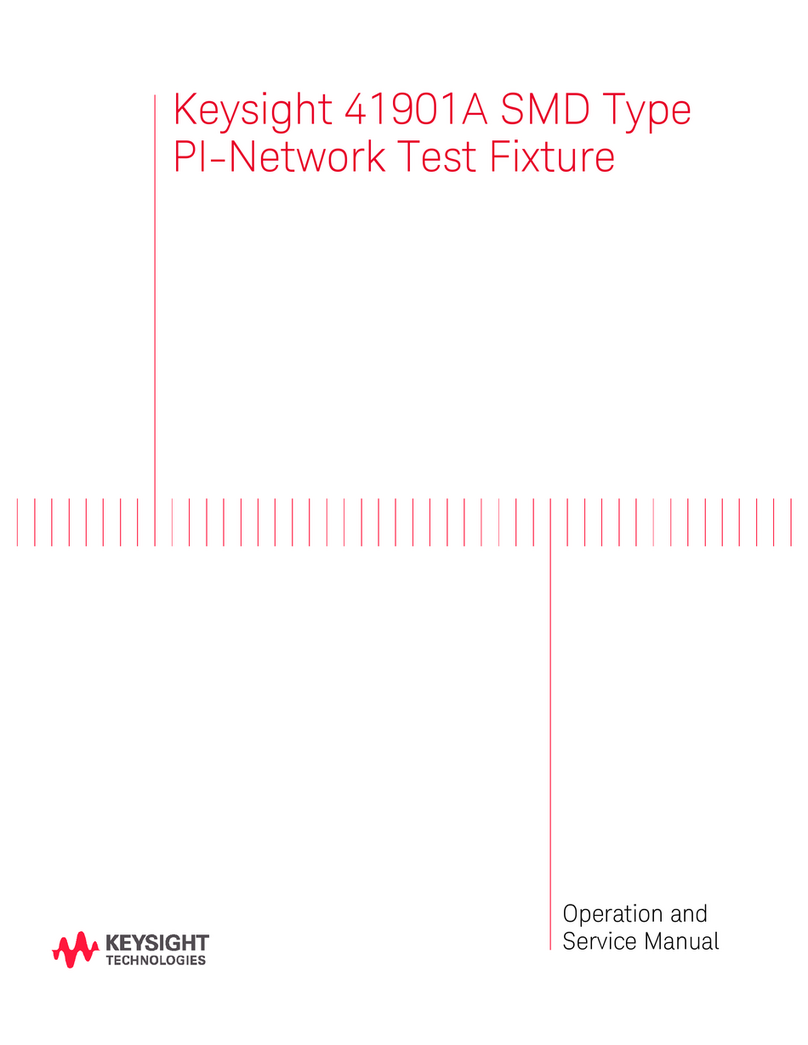
Keysight
Keysight 41901A SMD Operation and service manual

Parkside
Parkside PLEM 20 A3 Operation and safety notes
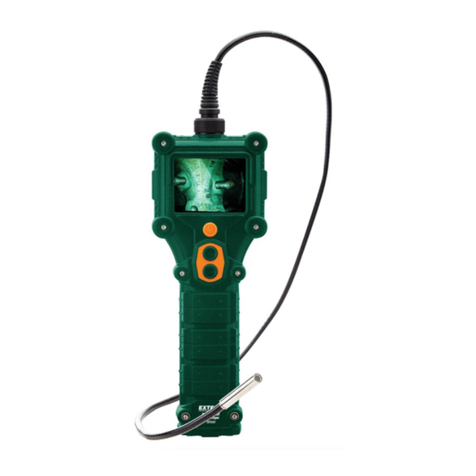
Extech Instruments
Extech Instruments BR300 user guide
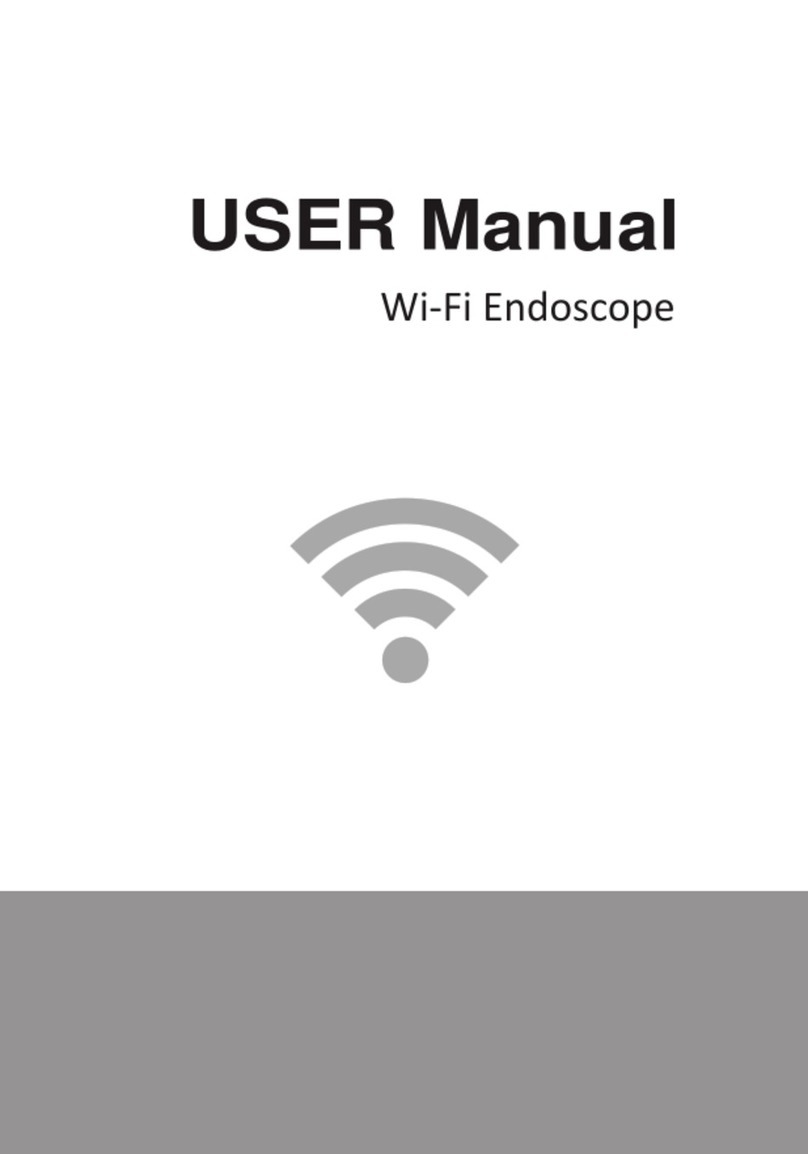
DB POWER
DB POWER WF-200 user manual
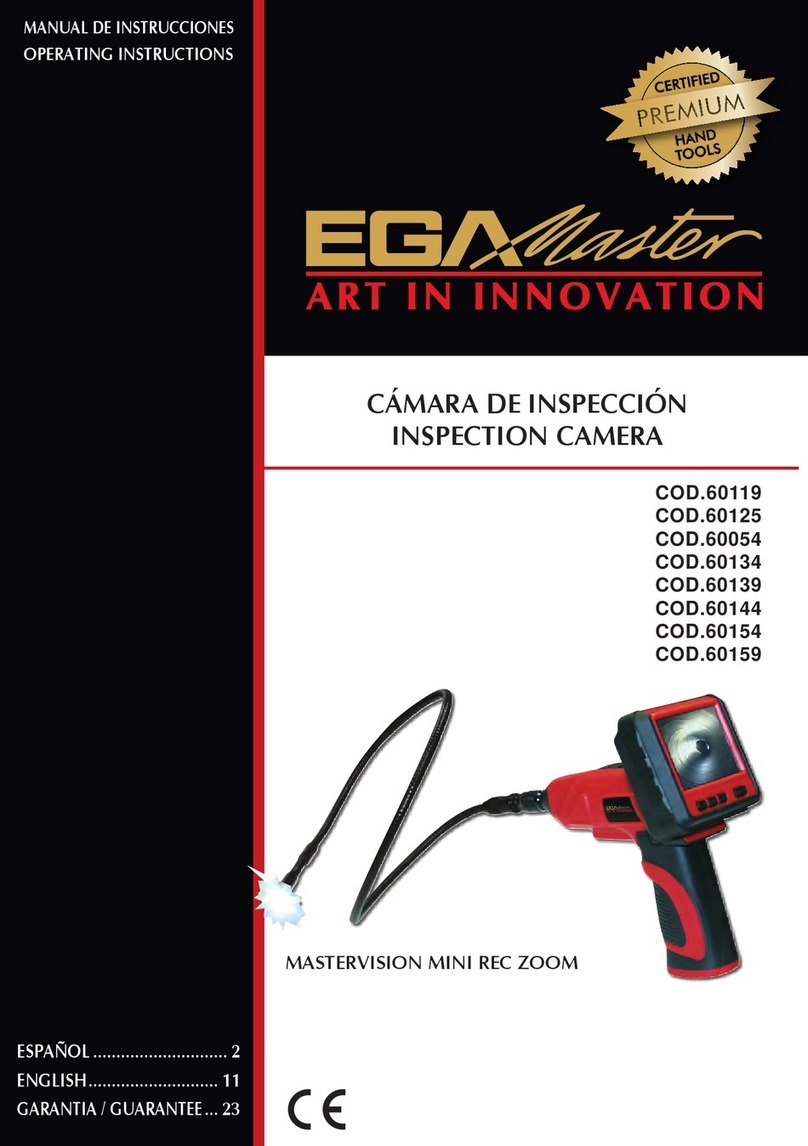
EGAmaster
EGAmaster MASTERVISION MINI REC ZOOM 60119 operating instructions
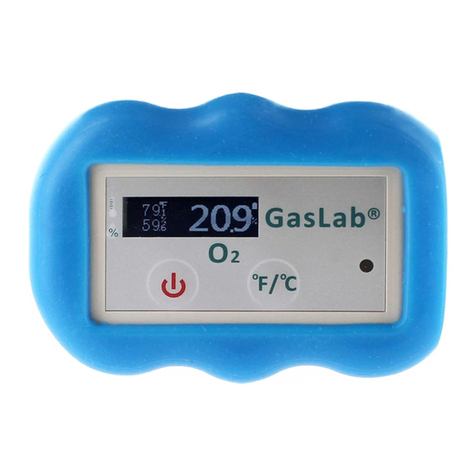
Co2meter
Co2meter GasLab SAN-102 user manual

